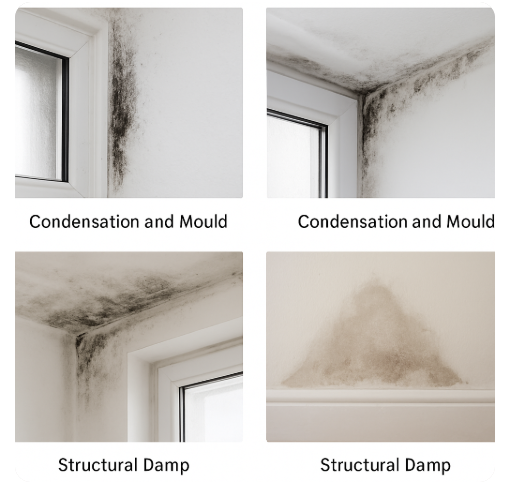Welcome to the Healthy Homes, Safer Breathing webpage. Here you will find useful information and links to resources that help improve quality of life, in a domestic setting, for people living with asthma.
Damp and mould in the home can make asthma worse – especially for children. In Herefordshire, we are working together to help families improve their housing conditions and reduce asthma symptoms.
Living in a home with mould or damp can:
- Trigger asthma attacks
- Make breathing harder
- Increase the need for hospital care
Further information on Asthma can be found on the Asthma and Lung UK website here: Asthma + Lung UK
Identifying and addressing damp and mould in homes is vital to protecting children’s health, particularly where a child has asthma.
********
The tabs below share useful information on damp and mould and how living conditions can be improved either by your own actions, a landlords, or local government agencies.
Damp is the presence of unwanted moisture in a building. It can be caused by condensation, leaks, rising moisture from the ground, or water coming in from outside. Damp creates the right conditions for mould to grow.
Mould is a type of fungus that grows in damp, poorly ventilated environments. It appears as black, green, or white spots, often with a musty smell. Mould releases tiny particles (spores) into the air that can cause or worsen breathing problems, especially for children with asthma.

If damp and mould are caused by everyday condensation and poor ventilation—such as steam from cooking, bathing, or drying clothes indoors—it may be possible to manage it with:
- Regular cleaning using safe mould removal products
- Improving ventilation (opening windows, using extractor fans)
- Keep rooms warm enough to reduce condensation. Do not use portable gas heater as they make the air very moist.
- Reducing moisture indoors (covering pans when cooking, keep doors closed to stop moisture moving around the home especially when using kitchen and bathrooms, using dehumidifiers, drying clothes outdoors where possible, use spin cycle on the washing machine twice to reduce water in clothes, close the door and open the window to allow moisture to escape)
- Reduce moisture by using dehumidifiers. Set to 60% if possible, close the doors and windows in that room to work more efficiently. Use of a Hygrometer can help monitor relative humidity levels. Recommended to keep level between 40-60%. Keeping rooms warm enough to reduce condensation
These steps are usually manageable by the household if the property is otherwise sound and free from leaks or structural issues.
Herefordshire Council has provided some further guidance which can be used for signposting on their housing pages which can be used to support families: Housing in Herefordshire – Herefordshire Council
Some damp and mould problems are caused by building faults or maintenance issues that cannot be resolved by cleaning or lifestyle changes alone. These include:
- Leaks from roofs, gutters, pipes, or windows
- Rising damp (moisture moving up through walls or floors from the ground)
- Penetrating damp (water coming through external walls)
- Poor or damaged insulation
- Broken or ineffective heating systems
- Damage to the structure of the property
In these cases, the root cause must be repaired by the landlord, housing provider, or a qualified contractor. Simply cleaning the mould will not prevent it from returning, and the problem can worsen over time—posing a significant risk to health.
The next step depends on the family’s housing situation.
Homeowners experiencing mould and damp may face repair costs that are beyond their immediate means, particularly if the issue is linked to structural faults such as roof leaks, damaged gutters, or poor insulation.
In Herefordshire, in some cases, provide financial assistance for urgent, small-scale repairs that address the source of damp and prevent further damage.
Access to this support is subject to a financial assessment of the household to determine affordability. Referring eligible homeowners to this service ensures that problems are tackled promptly, reducing health risks, especially for children with asthma, and preventing the issue from escalating into more serious or costly repairs.
More information can be found here: Help at home – Herefordshire Council
Check what’s already been done.
When visiting a home, first establish whether the family has already attempted to remove the mould or reduce damp for example, by cleaning affected areas or improving ventilation. If the issue persists, check whether they have informed their landlord or housing association about the problem, and when. This information is important, as it can help determine the next steps and whether legal timeframes for repair may already apply.
From October 2025, social landlords—including housing associations—must respond swiftly to mould and damp issues under Awaab’s Law. They are legally required to:
- Investigate emergency hazards (like severe mould) within 24 hours, and other damp-related hazards within approximately 10 working days.
- Provide tenants with a written summary of findings within 3 days after the investigation.
- Begin the necessary repairs within 5 working days of completing the investigation, or offer alternative accommodation if timely repairs aren't possible.
Failure to meet these strict timeframes can result in tenants taking legal action, seeking compensation, or lodging complaints with the Housing Ombudsman. These rules make prompt, accountable responses to mould-related risks non-negotiable for social housing providers.
More information on Awaab's Law can be found here: Awaab’s Law: Draft guidance for social landlords - GOV.UK
Some families may need help to raise concerns with their landlord—particularly if there are language barriers, literacy challenges, or previous unsuccessful attempts to report the issue. Support could involve making a phone call together, or sending an email or letter.
Contact details for local housing associations can be found on the Herefordshire Council housing page here: Housing in Herefordshire – Herefordshire Council
Suggested wording for a letter or email to a private landlord
Herefordshire Council’s Environmental Health team can support families dealing with mould and damp in their homes in several ways:
- Assessment and Inspection:
Environmental Health officers can visit the property to inspect and assess the extent of mould, damp, and any underlying causes such as leaks, condensation, or poor ventilation. - Advice and Guidance:
They provide practical advice to families on how to reduce mould and damp issues, such as improving ventilation, heating, and moisture control in the home. - Enforcement Action:
If the mould and damp problems are due to the landlord’s failure to maintain the property properly, Environmental Health can serve formal notices to landlords requiring them to carry out necessary repairs under housing health and safety regulations. - Support in Communication:
They can assist families in contacting landlords to report the problem in cases where the landlord is unresponsive. - Referral to Other Services:
If mould and damp issues are affecting a family member’s health, Environmental Health may work with healthcare professionals or housing support services to provide a coordinated response. - Follow-Up Visits:
To ensure problems are resolved, Environmental Health may carry out follow-up inspections after repairs or interventions.
Contact the team via this link: Contact us - MyHerefordshire
Early Help
The Children’s Help and Advice Team (CHAT), can advise the professionals supporting families with housing and financial challenges, which often intersect with issues like mould and damp. It might be that a single agency response is appropriate, or professionals may consider completing an Early Help assessment if the needs require a multi-agency response. An early help assessment can be used for families that meet level 2 and 3 of the Herefordshire Right Help Right Time levels of need. Support to complete this can be accessed through Herefordshire Council’s CHAT service.
By engaging Early Help, professionals can ensure families receive practical guidance and advocacy, including help in navigating communication with landlords or accessing other relevant services.
Early Help Assessment - resources for practitioners and professionals – Herefordshire CouncilBeing a parent – Herefordshire Council
Early Help is designed to provide timely support to families before problems escalate, offering a coordinated approach that addresses a broad range of needs. Since mould and damp in the home can significantly impact a child’s respiratory health, especially for those with asthma, Early Help can play a crucial role in improving the family’s overall situation.
The service goes beyond addressing immediate housing concerns. It takes a holistic view of the family’s circumstances, recognising how poor living conditions can affect not only physical health but also emotional and mental wellbeing. Through an Early Help Assessment, the family’s various needs including housing, health, and emotional support are gathered to create a tailored plan that coordinates input from different services. This integrated approach is particularly beneficial for families dealing with environmental health hazards linked to asthma.
Social Prescribing Link Worker
A social prescribing link worker in primary care connects families to community services that support their health and wellbeing beyond medical treatment. For a family with a child who has asthma and lives in poor housing with mould and damp, the link worker can help by:
- Guiding the family to housing support and environmental health services to address the mould and damp issues.
- Providing or connecting parents to mental health support to manage stress caused by difficult living conditions.
- Helping coordinate care that considers both the child’s asthma and the family’s wider social and emotional needs.
- Empowering the family to access ongoing support and build resilience.
In this way, the link worker helps improve both the physical health of the child and the overall wellbeing of the family.
Living Room
The Living Room helps families living in poor housing conditions by easing financial pressure through affordable access to food, which is especially important during the current cost-of-living challenges. When families spend less on groceries, they may have more resources available to address other urgent needs, such as heating their home properly to reduce mould and damp problems.
Additionally, by providing a supportive community space and access to advice on benefits, housing, and debt, The Living Room helps families navigate the wider challenges linked to poor housing. This holistic support can reduce stress and improve overall wellbeing, making it easier for families to cope with the combined pressures of health issues like asthma, difficult living environments, and financial strain.
Services - Talk Community Directory
Keep Herefordshire Warm Tel: 0800 677 1432
This is the advice line for all residents of Herefordshire run by the CIC Yes Energy Solutions. They will help residents as much as possible and triage for any energy efficiency grants that are available. They also have access to home visits, Energy Company Obligation (ECO4) and Household Support Funding to help residents with energy / utilities bills. This link can be used by professionals to refer residents: Refer a Herefordshire resident to us | YES Energy Solutions
Home Visits
Direct referrals for home visits can be made to: herefordshire
Alternatively you can send a direct referral by following this link Home Visits Herefordshire
The following is available: Draught proofing, radiator foils, LED lighting, CO monitors, hygrometers and temperature cards, energy saving devices, Measures will be fitted where appropriate, some homes will have more measures depending on the need. Some visits would be just general advice and CO alarms. The energy advisors can also signpost or refer to sources of funding and grants for those who are eligible.
Warm Homes Local Grant
This is run by Herefordshire Council who are looking to try and raise the energy efficiency of homes as defined by their energy performance certificates (bands D, E, F and G). Any fabric measures installed also comes with a ventilation strategy to ensure adequate air circulation. Eligibility and criteria are on the website and we encourage anyone to fill in an expression of interest as we can make further onward referrals if we cannot help them on this scheme, such as to ECO4.
Fire Service
The fire service can offer home safety visits that include checking for hazards like mould and damp. During these visits, they assess the home environment to help identify risks to health and safety, providing advice and referrals to the right services to support families living in poor housing conditions.
Severn Wye
Severn Wye Energy and Environment Trust is a charity that typically focuses on tackling fuel poverty—helping households struggling to afford heating and energy costs. They often provide services such as:
- Energy advice tailored to low-income or vulnerable households.
- Support for home insulation or heating improvements, which can increase energy efficiency and reduce fuel bills.
- Sometimes they offer grants or financial assistance to make homes warmer and safer.
Severn Wye Energy Agency – sustainability now, and for the future
Multi Agency Safeguarding Hub (MASH)
Referring to safeguarding is a vital step when a child with asthma may not be receiving the health support they need due to neglect or failure to attend medical appointments. In Herefordshire, if there are concerns that a child is being harmed or neglected including medical neglect such as being “was not brought” to required asthma reviews or treatments professionals must act promptly. The Multi-Agency Safeguarding Hub (MASH) Concerned About a Child? - Herefordshire Safeguarding Boards and Partnerships is the appropriate point of contact for such cases. You can report concerns by calling MASH at 01432 260800 (during working hours) or via the Multi-Agency Referral Form (MARF) Protect someone – Herefordshire Council if you're a professional. If it’s an emergency or the child is in immediate danger, always call 999 immediately.
Failing to bring a child to essential asthma‑related care could be a subtle yet serious form of medical neglect. Early intervention through safeguarding ensures the child’s health and safety remain the highest priority, connecting them with the necessary support and protection.



